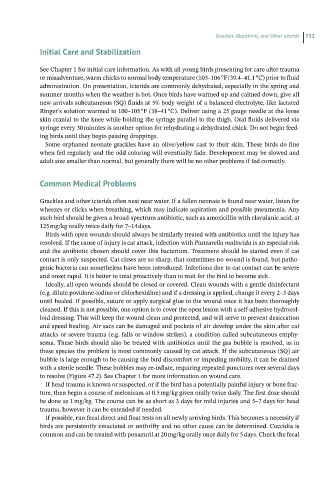Page 731 - Hand rearing birds second
P. 731
Grackles, Blackbirds, and Other Icterids 733
Initial Care and Stabilization
See Chapter 1 for initial care information. As with all young birds presenting for care after trauma
or misadventure, warm chicks to normal body temperature (103–106 °F/39.4–41.1 °C) prior to fluid
administration. On presentation, icterids are commonly dehydrated, especially in the spring and
summer months when the weather is hot. Once birds have warmed up and calmed down, give all
new arrivals subcutaneous (SQ) fluids at 5% body weight of a balanced electrolyte, like lactated
Ringer’s solution warmed to 100–105 °F (38–41 °C). Deliver using a 25 gauge needle at the loose
skin cranial to the knee while holding the syringe parallel to the thigh. Oral fluids delivered via
syringe every 30 minutes is another option for rehydrating a dehydrated chick. Do not begin feed-
ing birds until they begin passing droppings.
Some orphaned neonate grackles have an olive/yellow cast to their skin. These birds do fine
when fed regularly and the odd coloring will eventually fade. Development may be slowed and
adult size smaller than normal, but generally there will be no other problems if fed correctly.
Common Medical Problems
Grackles and other icterids often nest near water. If a fallen neonate is found near water, listen for
wheezes or clicks when breathing, which may indicate aspiration and possible pneumonia. Any
such bird should be given a broad‐spectrum antibiotic, such as amoxicillin with clavulanic acid, at
125 mg/kg orally twice daily for 7–14 days.
Birds with open wounds should always be similarly treated with antibiotics until the injury has
resolved. If the cause of injury is cat attack, infection with Pasteurella multocida is an especial risk
and the antibiotic chosen should cover this bacterium. Treatment should be started even if cat
contact is only suspected. Cat claws are so sharp, that sometimes no wound is found, but patho-
genic bacteria can nonetheless have been introduced. Infections due to cat contact can be severe
and onset rapid. It is better to treat proactively than to wait for the bird to become sick.
Ideally, all open wounds should be closed or covered. Clean wounds with a gentle disinfectant
(e.g. dilute povidone‐iodine or chlorhexidine) and if a dressing is applied, change it every 2–3 days
until healed. If possible, suture or apply surgical glue to the wound once it has been thoroughly
cleaned. If this is not possible, one option is to cover the open lesion with a self‐adhesive hydrocol-
loid dressing. This will keep the wound clean and protected, and will serve to prevent desiccation
and speed healing. Air sacs can be damaged and pockets of air develop under the skin after cat
attacks or severe trauma (e.g. falls or window strikes), a condition called subcutaneous emphy-
sema. These birds should also be treated with antibiotics until the gas bubble is resolved, as in
these species the problem is most commonly caused by cat attack. If the subcutaneous (SQ) air
bubble is large enough to be causing the bird discomfort or impeding mobility, it can be drained
with a sterile needle. These bubbles may re‐inflate, requiring repeated punctures over several days
to resolve (Figure 47.2). See Chapter 1 for more information on wound care.
If head trauma is known or suspected, or if the bird has a potentially painful injury or bone frac-
ture, then begin a course of meloxicam at 0.5 mg/kg given orally twice daily. The first dose should
be done as 1 mg/kg. The course can be as short as 3 days for mild injuries and 5–7 days for head
trauma, however it can be extended if needed.
If possible, run fecal direct and float tests on all newly arriving birds. This becomes a necessity if
birds are persistently emaciated or unthrifty and no other cause can be determined. Coccidia is
common and can be treated with ponazuril at 20 mg/kg orally once daily for 5 days. Check the fecal

